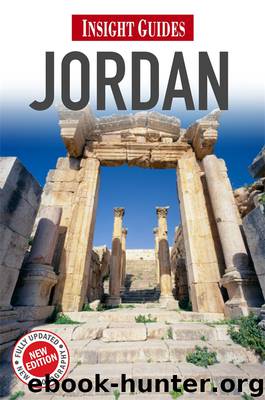Insight Guides: Jordan by Insight Guides

Author:Insight Guides
Language: eng
Format: epub
Tags: Travel and Holiday
Publisher: APA
Published: 2013-03-08T05:00:00+00:00
Dolmens, structures of four or five stone slabs (often associated in Europe with druids) were Bronze- and Iron-Age burials, probably introduced into the area by immigrant populations from other parts of the Middle East. The Jordan Valley boasts many, including at Kufr abil, the area south of Dayr ‘alla (in the hills east of the main road), Damya, Quttein and Matabi.
Around 5km (3 miles) southeast of Pella is the extraordinary site of Kufr abil, which boasts dozens of Paleolithic dolmens spread over a hillside (locals claim there are over 100). Around 15km (9 miles) east of Pella lies Bayt ‘aydis, the site of the so-called Jesus Cave (known locally as Kahf al-Messih), where, according to local tradition, Jesus stayed on his way to meet John the Baptist before his baptism. Apart from a stunning setting amid olive groves and barley fields where cicadas and turtle doves call, there are breathtaking views to Lake Tiberius, Umm qays, the (often snow-capped) Hebron Heights and northern Syria, as well as the cave itself, some old Roman rock-cut tombs thought to date to AD 21, an old Roman olive press with run-off channels carved into the rock, and an ancient olive tree. Nearby lie the ruins of a church with the remains of mosaics (though most have been extracted).
Ancient tels
The entire rift valley is dotted with ancient tels (artificial mounds formed by the cumulative debris from ancient settlements built of stone and mud-brick). Three of the most striking can be visited in the centre of the valley (west of the main road), and some of their excavated walls can be seen (though the sites have not been fully excavated and there is little if any information for the lay visitor) and few remains bar bare traces of ruins and shards – though the views are often spectacular.
The long double mound of Tel al-saydiyah 9 [map] was an important regional walled town for most of the Bronze and Iron Ages (3300–600 BC), and was also the site of a large caravanserai in the early Islamic period. It has been inconclusively associated with the biblical sites of Zaphon and Zarthan.
The smaller Tel mazar ) [map] to its south (and visible from the summit of Saydiyah) was a substantial settlement in the Iron and Persian periods, from the 11th to the 4th century BC.
The most dramatic of the three mounds is the 30 metre (100ft)-high Tel dayr ‘alla ! [map], towering over the main road at Dayr ‘alla village. Excavations have revealed almost continuous human habitation from 1600–400 BC, when it served variously as township, cultic centre, metal workshop, grain store, farm and a seasonal migration site. Its summit lies 200 metres (656ft) below sea level and some archaeologists believe it is the biblical site of Succoth.
About 7km (4.25 miles) east of Tel dayr ‘alla are the twin hills called Tulul al-dhahab @ [map] (“the little hills of gold”). Excavated architectural remains and pottery shards indicate that both hills were fortified settlements in the Early Iron Age and Late Hellenistic/Early Roman periods.
Download
This site does not store any files on its server. We only index and link to content provided by other sites. Please contact the content providers to delete copyright contents if any and email us, we'll remove relevant links or contents immediately.
The Rosie Effect by Graeme Simsion(3415)
The Mind Map Book by Tony Buzan(2550)
Come, Tell Me How You Live by Mallowan Agatha Christie(2230)
Iranian Rappers And Persian Porn by Maslin Jamie(2177)
Top 10 Dubai and Abu Dhabi by DK Travel(2078)
Belonging by Unknown(1839)
A Heartbreaking Work of Staggering Genius by Dave Eggers(1768)
Zeitoun by Dave Eggers(1622)
Bitter Lemons of Cyprus by Lawrence Durrell(1621)
In Arabian Nights by Tahir Shah(1537)
The Great Railway Bazaar: By Train Through Asia by Paul Theroux(1488)
The Abu Dhabi Bar Mitzvah by Adam Valen Levinson(1475)
House of Stone by Anthony Shadid(1423)
Fast Times in Palestine by Pamela Olson(1402)
The Saffron Tales by Yasmin Khan(1402)
Istanbul Travel Guide by Lonely Planet(1383)
Top 10 Israel and Petra by DK Travel(1375)
Twain, Mark - The Innocents Abroad by Twain Mark(1350)
Gertrude Bell by Georgina Howell(1307)
